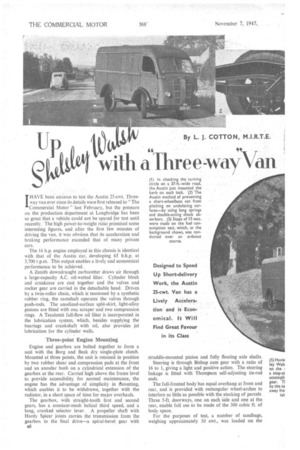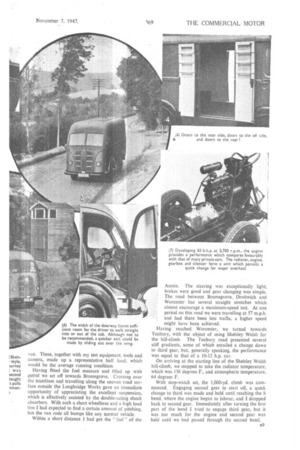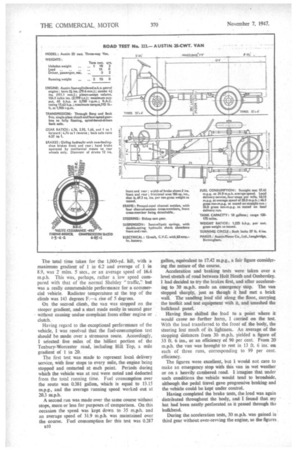with a Three-wdyVan
Page 42

Page 43

Page 44

Page 47

If you've noticed an error in this article please click here to report it so we can fix it.
IHAVE been anxious to test the Austin 25-cwt. Threeway van ever since its details were first released to "The Commercial Motor' last February, but the pressure on the production department at Longbridge has been so great that a vehicle could not be spared for test until recently. The high power-to-weight fatio promised some interesting figures, and after the first few minutes of driving the van, it was obvious that its acceleration and braking performance exceeded that of many private cars.
The 16 h.p. engine employed in this chassis is identical with that of the Austin car, developing 65 b.h.p. at 3,700 r.p.m. This output enables a lively and economical performance to be achieved.
A Zenith downdraught carburetter draws air through a large-capacity A.C. oil-wetted filter. Cylinder block and crankcase are cast together and the valves and rocker gear are carried in the detachable head. Driven by a twin-roller chain, which is tensioned by a synthetic rubber ring, the camshaft operates the valves through push-rods. The anodized-surface split-skirt, light-alloy pistons are fitted with one scraper and two compression rings. A Tecalemit full-flow oil filter is incorporated in the lubrication system, which, besides supplying the bearings and crankshaft with oil, also provides jet lubrication for the cylinder walls.
Three-point Engine Mounting Engine and gearbox are bolted together to form a unit with the Borg and Beck dry single-plate clutch. Mounted at three points, the unit is retained in position by two rubber shear and compression pads at the front and an annular bush on a cylindrical extension of the gearbox at the rear. Carried high above the frame level to provide accessibility, for normal maintenance, the engine has the advantage of simplicity in thounting, which enables it to be withdrawn, together with the radiator, in a short space of time for major overhauls.
The gearbox, with straight-tooth first and second gears, has a constant-mesh helical third speed, and a long, cranked selector lever. A propeller shaft with Hardy Spicer joints carries the transmission from the gearbox to the final drive—a spiral-bevel gear with et3 straddle-mounted pinion and fully floating axle shafts Steering is through Bishop cam gear with a ratio of 16 to 1, giving a light and positive action. The steering linkage is fitted with Thompson self-adjusting tie-rod ends.
The full-fronted body has equal overhang at front and rear, and is provided with rectangular wheel-arches to interfere as little as possible with the stacking of parcels Three 5-ft. doorways, one on each side and one at the rear, enable full use to be made of the 300 cubic ft. of body space.
For the purposes of test, a number of sandbags, weighing approximately 10 cwt., was loaded on the van. These, together with my test equipment, tools and camera, made up a representative half load, which would be the average running condition.
Having fitted the fuel measure and filled up with petrol we set off towards Bromsgrove. Crossing over the tramlines and travelling along the uneven road surface outside the Longbridge Works gave an immediate opportunity of appreciating the excellent suspension, which is effectively assisted by the double-acting shock absorbers. With such a short wheelbase and a high load line I had expected to find a certain amount of pitching, but the van rode all bumps like any normal vehicle.
Within a short distance I had got the "feel" of the
Austin. The steering was exceptionally light, brakes were good and gear changing was simple. The road between Bromsgrove, Droitwich and Worcester has several straight stretches which almost encourage a maximum-speed test. At one period on this road we were travelling at 57 m.p.h. and had there been less traffic, a higher speed might have been achieved.
Having reached Worcester, we turned towards Tenbury, with the object of using Shelsley Walsh for the hill-climb. The Tenbury road presented several stiff gradients, some of which entailed a change down to third gear, but, generally speaking, the performance was equal to that of a 10-12 h.p. car.
On arriving at the starting line of the Shelsley Walsh hill-climb, we stopped to take the radiator temperature, which was 138 degrees F., and atmospheric temperature, 64 degrees F.
With stop-watch set, the 1,000-yd. climb was cornmenced. Engaging second gear to start off, a quick change to third was made and held until reaching the S bend, where the engine began to labour, and I dropped back to second gear. Immediately after turning the first part of the bend I tried to engage third gear, but it was too much for the engine and second gear was held until we had passed through the second bend.
The total time taken for the 1,000-yd. kill, with a maximumgradient of 1 in 6-.2 and average of I i8.9, was Z mins. 5 secs., or an average speed of 1614, m.p.h. This was, perhaps, rather a low speed compared with that of the normal Shelsley "traffic," but was a really commendable performance for a commercial vehicle. Radiator temperature at the top of the climb was /43 degrees F.—a. rise of 5 degrees.
On the second climb, the van was stopped on thesteeper gradient, and a start made easily in second gear without causing undue complaint from either engine or clutch.
Having regard to the exec:eh:mat performance of the vehicle, I was resolved that the fuel-consumption test should be made over a strenuous route.. Accordingly, I selected five miles of the hdriest portion of the Tenbory-Worcester road, including Hill Top, a mile gradient of 1 in 20..
The first test was made to represent local delivery service, with four stops to every mile,. the engine being stopped and restarted at each point. Periods during which the vehicle was at rest were noted and deducted from the total running time. Fuel consumption over the route was 0381 gallon, which is equal to /3.15 mpg., and the average running speed worked out at 203 m.p.h.
A second run was made over the same course without stops, more or less for purposes of comparison. On this occasion the speed was kept down to 35 m.p.h. and an average speed of 31.9 m.p.h was maintained over the course. Fuel consumption for this test was 0.287 al 0 gallon, equivalent to 17.42 m.p.g., a fak figure considering the natureof the course.
Acceleration and. braking tests were taken over a level stretch of road between Holt Heath and Ombersley. t had decided to tryi the brakes. tlzst, and after accelerating to 30 m.p.h.. made an emergency stop. The van stopped, sharply, just as though it had met a brick wall,. The sandbag load slid along tile Roar, carrying the toolkit and test equiptagnt with it, and smashed: the bulkhead panel.
Having thus, shifted the Toad to. a point where it would cause no further harm, I carried on the test. With the load transferred to the front of the body, the steering lost tnuch of its lightness. An average of the stopping distances from 30m.p.h yielded a figure of 33 ft 6 ins., or an efficiency of 90 per cent. From20 m.p.h. the van was brought to rest in 13 ft. 6 ins. on each of three runs, corresponding to 99 per cent. efficiency.
The figures were excellent, but I would not care to make an emergency stop with this van in wet weather or on a heavily cambered road. I imagine that under such conditions the vehicle would tend to broadside, although the pedal travel gave, progressive braking and the vehicle could be kept under control.
Having completed the brake tests, the load was again distributed throughout the body, and I found that my hat had been neatly perforated as it passed through the bulkhead.
During the acceleration tests, 30E mph. was gained in third gear without aver-revving the engine, so the figures were correspondingly good. From 0 to 20 m.p.h. in second and third gears was accomplished in an average of 6.8 secs., and 0 to 30 m.p.h. in 12.2, secs. Acceleration from 10 to 20 m.p.h. in top gear was completed in 6.6 secs., and to 30 m.p.h. in 13.2 secs. • Owners of many private cars would find difficulty ;n equalling or bettering either the acceleration or braking figures obtained during this test.
On the way back to Longbridge we passed a point on the Droitwich-Bromsgrove road which we measured as 37 ft. wide. There I checked the turning circles. The van just climbed the kerb on each lock,. giving a figure of 37 ft. 4 ins, for leftand right-hand lock.
During the day we travelled 87 miles, but, by reason of the comfort of the vehicle and its ease of control, I did not feel fatigued in any way. The "Three-way "'Van is, indeed, a near approach to a private car, and for its purpose of local delivery work should gain great popularity. Not the least attractive of its many good features is the ease cif access to the goods compartment and the cab.




















































































